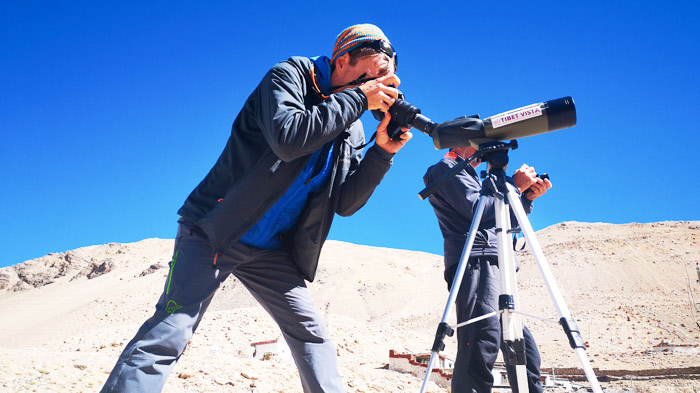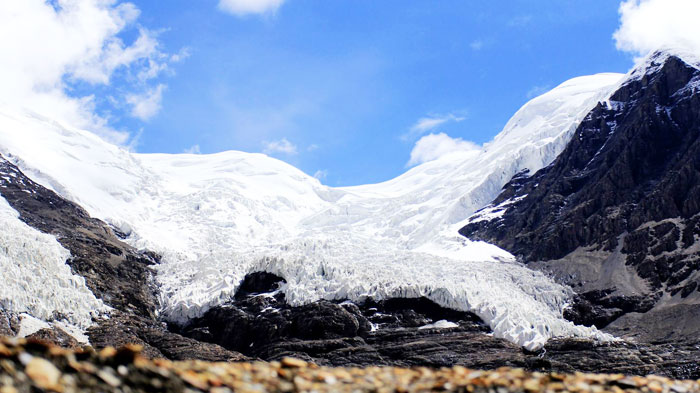
Tibet Landscape Photography: ultimate guide on Tibet photography tour
Speaking of landscape photography, no better lens can be found than a wide angle lens. The lens of inclusion enables photographers to seize the larger slice of the dramatic scene. As a great companion for the landscape photographer, the wide-angle lens adds a sense of dimension and depth to an image by making the object a bit further away than it really is. By using a wide or ultra wide angle lens, photographers can better present the majestic Tanggula mountains, boundless northern Tibet prairie, scared Namtso and breathtaking starry night at Everest Base Camp, etc. Recommended camera/lens: a full-frame DSLR , 16-35mm F.4, 35mm F1.4, 14-24mm F2.8, 24-70mm F2.8. Here are some photographic tips for different scenery:
Camera Settings for Tibet Landscape Photography:
Daytime
In the daytime, If you are exposed to bright sunshine, it is suggested that you set your camera to AV mode (also known as Aperture mode). You decide the Aperture (how much light you want your camera sensor to get from lens), to F2.8 for example, and the rest is left to be decided automatically by the camera meanwhile you adjust ISO to 100 to obtain the best image quality. While if you step into the dark monastery, to avoid taking blurred image you’d better switch the camera to M mode (manual mode) and set Aperture to around 140-160 per second and ISO to around 400-600, and you can lower or raise it depending on the actual situation.
 Shooting the natural landscape on the roof of the world - Tibet.
Shooting the natural landscape on the roof of the world - Tibet.
Nighttime
At night, if you want to capture heavenly starry night at EBC, you have to have a camera, a tripod, and a remote shutter release. Then, secure your camera to the tripod and set your ISO to 100 and Aperture to 10 second-5min. (the longer the exposure time, the brighter the image will be.) If you don’t want to have a long starry track in your photos, you can choose M mode and use large Aperture like F1.4-2 and bump up your ISO to 2500-3500.
Snow scenes
Taking photos in snow-capped mountainous areas, you should set your white balance manually when auto white balance fails under the influence of strong reflection of the snow. As you compose your image, you may include darker foreground to add contrast to white snow. Another important thing is to protect your camera from cold and moisture. You can prepare a plastic bag to wrap your camera, and the battery drains quickly, so do not leave it exposed to the cold.
Yamdrok Lake
There is something alluring about lake reflections in landscape photography, especially when surrounded by majestic snow capped mountains that glow from the light of the setting sun. And with the hills and mountains around Lake Yamdrok, it is a stunning scene for some great reflection and sunset photography. The main thing to remember is to not shoot too wide. Regardless of whether you are using full frame, APS-C, or MFT, super wide shots do not work, as they reduce the size of the epic mountain background and magnify the lake in the foreground. With Lake Yamdrok being such a huge, expansive lake, spread out over a massive area, it is best to shoot it in sections from the best angles, rather than try to capture as much in each shot as possible.
 Yamdrok Lake, one of the Great Three Holy Lakes in Tibet.
Yamdrok Lake, one of the Great Three Holy Lakes in Tibet.
However, with the length of some of the sections of Yamdrok, the wider the better is the way to go. If you can get a good shot down a long length of the lake, then the dramatic effect really showcases how long this lake really is.
For most lake photography with a backdrop of mountains, shooting with anything wider than 35mm on a full frame will make the background seem too distant, even though it is. It is better to zoom in past 50mm, or even 100mm focal length, to bring the background into perspective with the foreground. It is also a good idea to not focus on clouds in the sky, and concentrate on the main focus of the shot, the lake. Zooming in somewhat to fill the frame with the lake and mountain backdrop can be more impressive when you look at the shot on a computer afterwards, even though it does not seem obvious through the viewfinder.
Everest Base Camp
Everest Base Camp is also a great place to take photos of mountains, and everyone wants a great shot of the highest mountain in the world. One of the best tricks when photographing mountains is to use the “thirds” rule. If you set your horizon to the middle of the viewfinder, you will find later that your photos are lacking something. The general rule in mountain photography is to split the frame into three vertical sections; the top third is the sky, the middle third the background, and the lower third is the foreground or subject. This works well when photographing at Everest Base Camp, since the base camp itself takes up the foreground third, leaving the mountain in the middle of the frame. This places the peak, with its cloud flag, in the lower portion of the upper third, giving you a perfectly proportioned shot of the mountain, although it is ok to allow them to overlap a little sometimes.
 Capturing the imposing Mt. Everest from Everest Base Camp.
Capturing the imposing Mt. Everest from Everest Base Camp.
Balancing sharpness and depth of field are also tricky, especially when you are shooting a mountain that is as far away as Everest from the base camp. On most camera lenses the “ sweet spot” will define where you focal length should be set, and this can change from lens to lens, although on average it is normally from F8-F11. The depth of field is more complicated, and if you want your background and foreground to both be in focus, you need to extend your F-stop number further towards f22 to get the whole image in focus. This may reduce the sharpness a little, but it will guarantee your focus is even. Experimentation in the field is the best way to get it just right, so get out and try it.
Karola Glacier
Photographing glaciers, despite their grandeur, can be somewhat challenging, but there are some simple tips to help you get the best of your photos of the stunning Karola Glacier.
While it may be tempting to get out the wide-angle lens and get a shot of the whole glacier, this kind of image reduces the effect of the enormity of the glacier by making it look smaller and less impressive. The initial awe of standing in front of such a devastating force of nature is best captured using a little zoom, and shooting only a section of the glacier to give it context and scale. Adding a few easily recognizable structures, such as the chortens on the viewing deck, you can give the glacier more perspective on its real size.
 The amazing view of Karola Glacier is shot on a clear day.
The amazing view of Karola Glacier is shot on a clear day.
Looking for shadows and darker parts can help to give this pristine white glacier a little texture. Make sure you are not shooting with the sun at the midday point, so that shadows can enter the picture, and show the real jagged surface of the glacier as it is seen in real life. Glaciers move and shift a lot, and produce cracks and crevices that form darker spots in the pristine white when viewed with the sun to one side.
The fact that the Karola Glacier looks as if it belongs on some alien world is one of its most photogenic features. Use the odd angles, striking colors, and atypical forms to cut across the photo in different ways, and use the oddness of other features to make each shot different and unique.
Highlights of Tibetan Landscape Photography in Different Regions
Highlights in Lhasa
While there are many things to photograph in Lhasa city, out in the surrounding area the landscape is stunning as well. From the stunning Lake Yamdrok and Kamba-la Pass to the beauty of the Nyenchen Khangsar Mountain and the Brahmaputra River, there are many spectacular aspects of the local landscape that are worth photographing. Check more details at Lhasa Travel Guide
Highlights in Shannan
One of the biggest attractions in Shannan prefecture is the amazing Lake Yamdrok. Stretching for miles in several directions, this odd-shaped lake is really a series of smaller lakes that are all interconnected with no outlet. The whole area is filled with low mountains and lush green landscapes that are the delight of photographers, and the Lhamo La-tso Lake is said to have the magic power of showing the past and future. Check more details at Shannan Travel Guide
Highlights in Shigatse
In the area around Shigatse, the landscape is different from that of the Lhasa Valley, and many of the rock formations contain volcanic layers with bands of color. There are also many fields in the area where the local farmers grow the famous highland barley that forms part of the diet of every Tibetan. During summer, before the harvest, the fields become a sea of barley rippling in the wind like a huge, golden lake. And don’t forget the spectacular sight of Mt. Everest Base Camp. Check more details at Shigatse Travel Guide
Highlights in Nyingchi
Nyingchi is the land of peach blossoms, and the beautiful valleys stretch as far as the eye can see. Filled with Swiss-style alpine valleys between high mountains, it is hard to take in the fact that the barren plateau of Tibet can actually include such a beautiful, green landscape. Add to that the Basum-tso Lake, the Lulang grasslands, Midui Glacier, and the Yarlung Zangbo Grand Canyon, and you have a photographic adventure in the making. Check more details at Nyingchi Travel Guide
Highlights in Nagqu
Nagqu Prefecture to the north of Lhasa is a huge expanse of natural landscape that will take your breath away. From the picturesque sight of Lake Nam Co, surrounded by high mountains, to the wide expanse of the Changtang grasslands where the local people race horses on festivals and the yaks roam free with the wild donkeys. Check more details at Nagqu Travel Guide
Highlights in Ngari
In the far northwest of Tibet lies the prefecture of Ngari, part of the huge expanse of the plateau that is mostly uninhabited by people, and a haven for dozens of different species of wild animals. The best sights to photograph, apart from this massive barren prairie are the holy sites of Mount Kailash and Lake Manasarovar, and the wasteland that contains the ruins of the ancient Guge Kingdom. Check more details at Ngari Travel Guide
Join-in Most Classic Tibet Photography Tours

The Lhasa-born prodigy used to study business overseas, and got his Bachelor of Business in Nepal and India before moving back to his homeland. With pure passion for life and unlimited love for Tibet, Kunga started his guide career as early as 1997.
Responsible, considerate, and humorous, he devoted his entire life to guiding and serving international tourists traveling in Tibet. As a legendary Tibetan travel guru with 20-year pro guide experience. Currently, he is working in Tibet Vista as the Tour Operating Director. Whenever our clients run into trouble, he is your first call and will offer prompt support.


.jpg)



0 Comment ON "Tibet Landscape Photography: ultimate guide on Tibet photography tour"